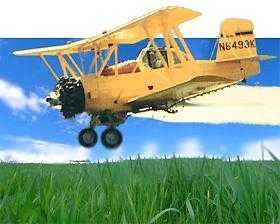Sun, Apr 28, 2024
NAAA Reminds Drone Operators to Yield to Agplanes
As the U.S. agricultural season kicks into high gear, the National Agricultural Aviation Association (NAAA) is calling on both professional and hobbyist drone operators to exercise heightened awareness and caution during their flights.

This appeal aims to mitigate the risks of aerial collisions as low-flying manned agricultural aircraft commence their crucial work over the nation's croplands.
Agricultural aviators are responsible for treating an impressive 127 million acres of U.S. cropland annually. These operations often occur at altitudes as low as 10 feet, at speeds up to 140 mph, making it extremely challenging for pilots to detect and avoid drones, which are typically mandated to fly below 400 feet without specific waivers from the FAA.

Andrew Moore, CEO of NAAA, emphasizes the critical nature of this issue: "It is extremely difficult, if not impossible, for manned aircraft to see a drone while conducting crop-enhancing and other aerial applications at low altitudes and high speeds. We urge drone operators to equip their UAS with detect and avoid technology and to always yield the right of way to manned aircraft to ensure a safe growing season."
The NAAA highlights several guidelines for drone operators to follow:
- Always give right of way to manned aircraft, as required by law.
- Equip drones with visible strobe lights, distinctive markings, and tracking technologies like ADS-B In systems.
- Obtain proper certification and training for safe and effective drone operation.
- Consult local agricultural operations before flight by using resources like the Find An Aerial Applicator database available at AgAviation.org.
- Land drones immediately if a low-flying manned aircraft is spotted nearby.
- Maintain adequate unmanned aircraft liability insurance.
These precautions come in response to an NAAA survey where 11% of agricultural pilots reported encountering a drone during flight operations last year, underscoring the growing concern over safe airspace cohabitation.
The FAA also supports these safety measures and will highlight them during their annual Drone Safety Day, reflecting the ongoing commitment to integrating drones safely into national airspace. As drone registrations and the number of certified remote pilots continue to rise sharply, the importance of conscientious drone operation cannot be overstated.
More News
Aero Linx: International Federation of Airworthiness (IFA) We aim to be the most internationally respected independent authority on the subject of Airworthiness. IFA uniquely combi>[...]
Ultrahigh Frequency (UHF) The frequency band between 300 and 3,000 MHz. The bank of radio frequencies used for military air/ground voice communications. In some instances this may >[...]
A Few Questions AND Answers To Help You Get MORE Out of ANN! 1) I forgot my password. How do I find it? 1) Easy... click here and give us your e-mail address--we'll send it to you >[...]
From 2019 (YouTube Edition): Learning To Paint Without Getting Any On Your Hands PPG's Aerospace Coatings Academy is a tool designed to teach everything one needs to know about all>[...]
Also: Sustainable Aircraft Test Put Aside, More Falcon 9 Ops, Wyoming ANG Rescue, Oreo Cookie Into Orbit Joby Aviation has reason to celebrate, recently completing its first full t>[...]
 ANN's Daily Aero-Linx (05.06.25)
ANN's Daily Aero-Linx (05.06.25) ANN's Daily Aero-Term (05.06.25): Ultrahigh Frequency (UHF)
ANN's Daily Aero-Term (05.06.25): Ultrahigh Frequency (UHF) ANN FAQ: Q&A 101
ANN FAQ: Q&A 101 Classic Aero-TV: Virtual Reality Painting--PPG Leverages Technology for Training
Classic Aero-TV: Virtual Reality Painting--PPG Leverages Technology for Training Airborne 05.02.25: Joby Crewed Milestone, Diamond Club, Canadian Pilot Insurance
Airborne 05.02.25: Joby Crewed Milestone, Diamond Club, Canadian Pilot Insurance




